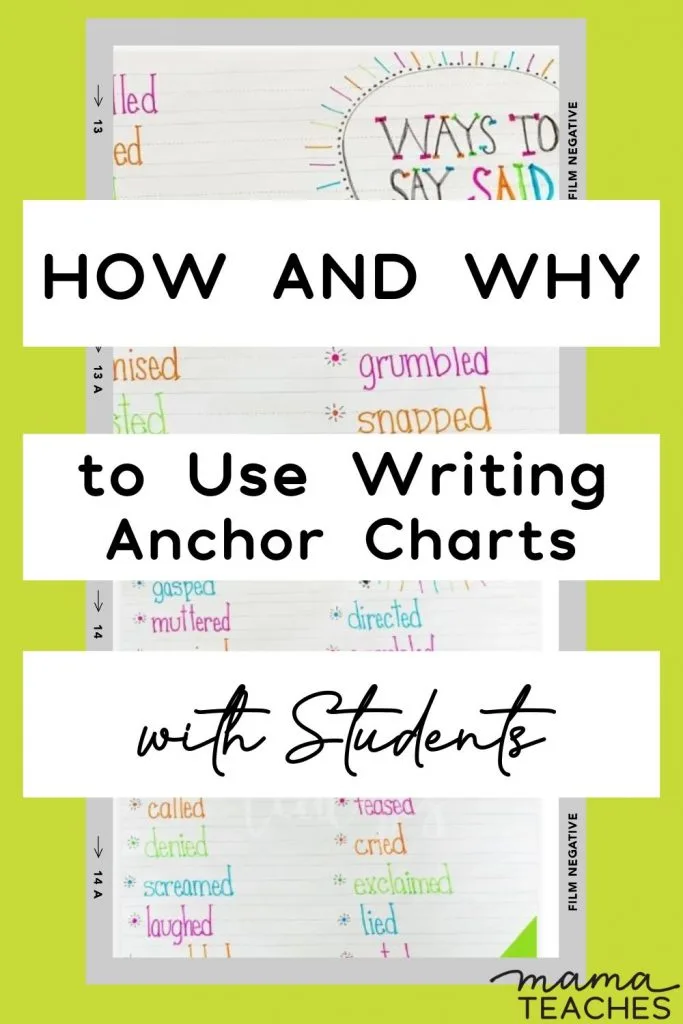Do you feel like banging your head against the wall when teaching writing?
Anchor charts to the rescue!
These all-important writing tools will ease frustration for you and your students.

This article contains affiliate links to things that you might like.
What Are Anchor Charts?
Anchor charts are visual references that help your students work independently.
They are the nuts and bolts of your instruction arranged in a straightforward, engaging way (typically a one-page chart or graphic).
An anchor chart is the reference tool for the student.
Instead of asking you what to do next (or sitting there staring out the window), the student follows the step-by-step guidelines on the anchor chart to complete the assignment.
You can tell a student one hundred times that a well-written paragraph starts with a topic sentence, has three supporting sentences, and ends with a concluding sentence, but he may blank when he has to do it himself.
With the visual reminder and reference tool (a.k.a. the anchor chart), the student can follow the template and write the paragraph with no reminders from you.

How to Make an Anchor Chart
An effective anchor chart is the following:
Includes Only the Essentials
All anchor charts are not created equal.
The best anchor charts contain only the essentials.
They should not be a transcript of your instruction.
The student has already heard the lesson.
Anchor charts should include the main ideas or keywords to jog the student’s memory.
Is Visually Appealing and Memorable
If possible, the anchor chart should have a graphic element.
This keeps the chart organized and visually appealing.
My favorite anchor chart for the paragraph is the hamburger.
It’s a great visual and is quite memorable.
Fits on One Page
The best anchor charts are one page, so you can place them in a sleeve protector for easy reference.

How to Use Anchor Charts
How do you use writing anchor charts?
It’s as easy as 1-2-3.
1-Give the Lesson
Teach the writing lesson as you usually would.
If you have a large-size version of the anchor chart (or you can project it), refer to it as you teach.
2-Hand Out the Anchor Chart
Give each student a copy of the anchor chart.
I like to print charts on cardstock and/or slide them in sleeve protectors so they will stand up over time. An anchor chart can be used again and again.
If this is the first time the student is seeing this anchor chart, go through it question and answer style.
(e.g., “What is the first thing you do?” or “How do you decide on a title?”)
3-Consider Adding a Graphic Organizer
Arrangement is one of the most challenging aspects of writing.
This is particularly true for students who struggle with dysgraphia.
Having a companion, fill-in-the-blank graphic organizer can help struggling writers organize their thoughts.
The anchor chart provides the reference, and the graphic organizer is a place to record and categorize the parts of the story or paper.

Ideas for Writing Anchor Charts
Here are some ideas for writing anchor charts.
Other Ways to Say “Said”
This FREE anchor chart has a list of verbs that you can swap out for the overused word “said.”
Paragraph Anchor Chart
Learning to write a paragraph is a fundamental writing skill.
This hamburger anchor chart pack has digital and print versions of the anchor chart and a companion graphic organizer.
How to Decide on a Title
Students often flounder when deciding on a title.
An anchor chart can walk them through just how to title their story or paper.

5 Parts of a Sentence
What are the parts of a sentence?
An anchor chart can remind students to begin with a capital letter, end with a mark of punctuation, include a subject and a verb, and make sure the words make complete sense.
Parts of a Story
What are the parts of a story?
It all starts with characters, setting, problem, and solution.
Using Anchor Charts for Writing
Most students need help to learn how to write.
They must practice the process over and over.
This is where anchor charts can be helpful.
They break the process down into manageable chunks and cue the student on what to do next.
Anchor charts can ease the frustration of both students and teachers by making students more independent.
